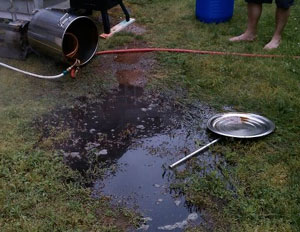This year, as in years past, Steve Wilkes and I gathered around a microphone to share stories about brewing disasters sent in by listeners of Basic Brewing Radio. All were sent in with a spirit of fun, even though some of them end in ruined beer, property damage, or even personal injury. After reading dozens of letters, certain themes emerge – themes that we can all learn from in our brewing efforts. Here are my top five.
1. Fire: Bad
As Phil Hartman’s Frankenstein’s monster reminded us, fire (and heat) can be our friend or our enemy. Whether it’s flame coming directly from the burner or the residual heat from recently-heated brew pots and other implements, skin raised to a certain temperature will experience discomfort and a change of appearance (please don’t attach any more pictures of such appearance changes with future disaster email messages). Also, brewing gear that is not meant to be heated directly by fire, such as rubber gas hoses, shall suffer from such contact.
2. Watch That Pot
Just like bar tabs, attention is something that should be paid – especially when it comes to boiling wort. A watched pot never boils, but it also hardly ever boils over. My first brewing disaster happened when I turned my attention to my barking dog in the backyard. When I returned to the stove, my bittering hops, along with a good portion of my wort, were spreading nicely across my stovetop. Once the boil has been established, it doesn’t need as much babysitting.
3. Tight Connections
Brewers often report disasters that happen because hoses and fittings seem to want some time apart from one another. Pump hoses have come off and sprayed hot wort all over unsuspecting brewers and their floors. Tap hoses have leaked, robbing brewers of precious CO2 and flooding chest freezers and basements. Even a tiny slow leak can have disastrous consequences over a period of time.
4. Fermenter or Fountain?
Clogged airlocks and blowoff tubes are also reported often as the source of disaster fun. Mopping the ceiling after a plugged carboy bung has taken flight is a fairly common occurrence. Less common, but more funny, is standing over a carboy, taking out a plugged bung, and enjoying a surprise shower of precious beer. Severely plugged carboy necks have led to flying plastic lids and exploding fermenters, which brings us to number five.
5. Cut Glass – or Glass Cuts
Slippery glass carboys can cause a disaster and are potentially deadly. An empty glass carboy is fairly heavy and unwieldy. Fill them up with wort or must, and that characteristic is magnified. Walk across an icy patio or driveway, and watch your insurance rates go up. We’ve read several tales of brewers’ dropping both empty and full glass carboys and sometimes getting stitches as a result.
Bonus: Too Much Fun
Many of the stories we read, and some of the funniest, come as a result of enjoying the final product of brewing while working to make more. On the negative side, ingredients and brewing steps can be forgotten. On the positive side, sometimes new tasty beers are discovered as a result. And, sometimes some liquid refreshment with friends can help take the edge off an otherwise frustrating brewday.
Final Thoughts
We encourage you to take notes as you brew to ensure that you remember both your successes and your failures. We learn equally from both. We also encourage you to clean up your messes thoroughly, so your spouses and significant others will allow you to live to brew another day.
—
Related articles


Speak Your Mind